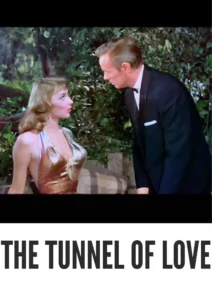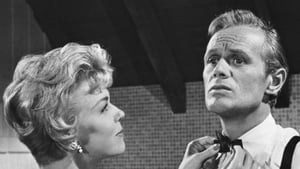Video Sources 0 Views

Synopsis
Dive into the delightful domestic dilemmas of The Tunnel of Love, a charming romantic comedy from 1958, now beautifully colorized for a fresh and engaging viewing experience. Starring the incomparable Doris Day and the versatile Richard Widmark, this film explores the humorous challenges faced by a suburban couple trying to start a family. Perfect for fans of classic comedies and those who appreciate witty storytelling, this HD download offers a heartwarming and entertaining escape into the vibrant world of 1950s suburbia.
The Tunnel of Love centers around Isolde and Augie Poole, a seemingly perfect suburban couple who are struggling to conceive a child. Augie, a cartoonist, and Isolde, a loving wife, live a comfortable life in Connecticut, but their happiness is incomplete without a family.
As they navigate the complexities of adoption, their lives become entangled in a series of comical misunderstandings and awkward situations. Augie’s flirtatious nature leads to suspicion and jealousy when he poses as an artist for a young, attractive woman named Alice, who is also being considered for adoption. Meanwhile, Isolde’s determination to become a mother leads her to explore various unconventional methods, adding to the comedic chaos. The film cleverly satirizes the societal pressures surrounding marriage and parenthood, highlighting the absurdities and anxieties of suburban life. The Tunnel of Love is a lighthearted and witty exploration of love, marriage, and the pursuit of family, filled with memorable characters and laugh-out-loud moments.
The film boasts a stellar cast of actors who bring these endearing characters to life:
-
Doris Day as Isolde Poole
-
Richard Widmark as August “Augie” Poole
-
Gig Young as Dick Pepper
-
Gia Scala as Estella Novotny
-
Elisabeth Fraser as Alice Pepper
The Tunnel of Love firmly resides in the romantic comedy genre, with elements of satire and social commentary that add depth and relevance to the story. Its lighthearted tone and focus on marital relationships make it a quintessential example of 1950s comedic filmmaking.
Released in 1958, The Tunnel of Love reflects the prevailing social norms and cultural anxieties of the era. Set against the backdrop of post-war suburban America, the film explores themes of marriage, parenthood, and the pursuit of the American dream. It offers a humorous yet insightful commentary on the pressures faced by couples to conform to societal expectations. The film’s depiction of gender roles and marital dynamics provides a fascinating glimpse into the social landscape of the 1950s.
This colorized version of The Tunnel of Love has been meticulously restored using state-of-the-art digital techniques, enhancing the visual appeal while preserving the film’s original charm and wit. The colorization process involved carefully analyzing the grayscale tones of the original black and white footage and assigning appropriate colors to each scene. The techniques employed included advanced algorithms for color palette selection and image enhancement. This painstaking process breathes new life into the characters and settings, making the story even more engaging for contemporary audiences. While some purists may debate the merits of colorizing classic films, it introduces these films to a wider audience, ensuring their longevity for future generations.
-
: Gene Kelly
-
: Joseph Fields
-
: the play The Tunnel of Love by Joseph Fields and Peter De Vries, and the novel by Peter De Vries
-
: Robert J. Bronner
-
: John McSweeney, Jr.
-
: Metro-Goldwyn-Mayer
-
: Metro-Goldwyn-Mayer
-
: 98 minutes
-
: MP4
-
: HD (1080p)
-
: Compatible with most devices, including smartphones, tablets, computers, and smart TVs.
The Tunnel of Love (1958) was well-received upon its release, praised for its witty script, charming performances, and clever direction by Gene Kelly. The film’s lighthearted approach to sensitive topics resonated with audiences, making it a box office success. While it may not be considered a groundbreaking work of cinematic art, it remains a beloved example of classic Hollywood comedy and a testament to the enduring appeal of Doris Day and Richard Widmark.
-
: What is The Tunnel of Love about?
-
A: The Tunnel of Love is a romantic comedy about a suburban couple struggling to start a family and the comical situations that arise as they navigate adoption and marital challenges.
-
-
: Is The Tunnel of Love (1958) a well-known Doris Day film?
-
A: Yes, The Tunnel of Love is a popular Doris Day film, known for its lighthearted humor and charming performances.
-
-
: Is this version of The Tunnel of Love colorized?
-
A: Yes, this version has been professionally colorized to enhance the viewing experience.
-
-
: What makes The Tunnel of Love interesting for classic film fans?
-
A: The Tunnel of Love offers a glimpse into the social norms and cultural anxieties of 1950s suburban America, providing a humorous yet insightful commentary on marriage, parenthood, and the American dream.
-
-
: What is the download format?
-
A: The download format is MP4, which is compatible with most devices.
-
-
: What resolution is the download?
-
A: The resolution is HD (1080p), providing a high-quality viewing experience.
-
Watch The Tunnel of Love Today!











